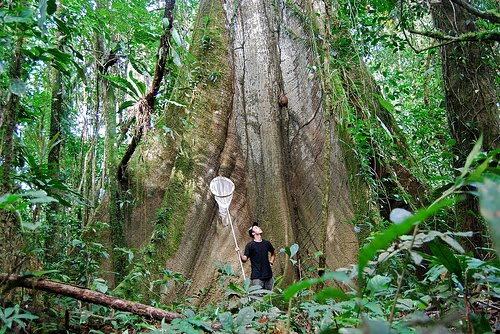Since I haven’t had a chance to write in a while, this is going to be a long one, so…
I arrived in Quito last night after a particularly long and worrisome bus trip up from the lowlands. The night before last, a police demonstration against some proposed cuts in benefits turned into a violent confrontation; several of the sensationalist media outlets, of course, called it a ‘golpe de estado’, which means ‘coup’! The president had tear gas fired at him, was taken to the police hospital, and was subsequently held captive in the hospital by the police before being rescued by the military. The airport was stormed by the military and the police put up roadblocks… luckily, the escalation to violence ended there, with only one person dead and about 50 injured. Needless to say, I was a bit worried about what would happen when I arrived in Quito. Luckily, everything seems to have calmed down, and life in the capital appears to be back to normal…
 |
| The Ecuadorian president, Rafael Correa (left), telling his 'captors' that if they want to kill him, then, well, they should just 'go ahead and do it'. |
My month stay at Yarina was excellent. My time was roughly divided between checking and baiting my traps, collecting butterflies with my hand net, and helping out at the lodge. At first, when the management asked me if I could help out with some ‘translations’, I thought this would entail translating brochures, web pages, etc. However, what they needed was translating for guests, so I accompanied a native guide and translated his tours. This turned out to be one of the most rewarding aspects of my stay. I learned a great deal about the medicinal, and sometimes non-medicinal, uses of many of the rainforest plants. For example, I learned what plants are used to make curare, a poison that the Kichwa indians used to use to poison their darts for hunting, and also about plants that are used for an extremely wide variety of ailments and conditions of all sorts. I used my position to inform guests about the marvelous diversity of insects and other critters found in the rainforest, and I think they all enjoyed my excessive enthusiasm… I even captured my first caiman!
 |
| Showing off my super-amazing caiman-wrestling skills! |
Now, back to butterflies...
The living world is exceedingly complex, and opportunities for generalization rarely present themselves. For precisely this reason, ecologists have had a difficult time describing biological systems in terms of universal rules or laws. Nowhere is this more true than in the tropics. The rainforest in particular is a place of contradictions; extraordinarily high diversity but relatively low individual abundance. But then there are some abundant species; however whose abundance may be highly heterogeneous throughout the range. The forest is seemingly stable yet is constantly changing and highly volatile. Disturbance has certainly played a role in the high diversity found there, but not too much nor too little. Basically, everything you’ve heard about the rainforest is true – and not.
One of the few ecological ‘laws’ that ecologists talk about is a positive relationship between abundance and distribution. That is to say that species that are found in higher numbers at a particular location also tend to be found over a wider geographic area. For instance, the monarch butterfly is easily found wherever it occurs, and in high numbers. The species also has an enormous range, from Canada to South America. There are, in contrast, many species of butterflies – like several species of hairstreaks for example – that are found only in isolated areas, and are also only rarely encountered. Similar examples abound in the natural world, in plants and animals of all sorts.
While much evidence for this positive relationship exists, the majority of evidence comes from birds and mammals in temperate areas. Very little support comes from insects, and even less from insects in the tropics. In contrast, the vast majority of the world’s biodiversity lies precisely here – in the insect communities of the tropical rainforest. In my opinion, any ecological law that neglects to consider this group of animals isn’t that general at all. So, I’m here in the Ecuadorian Amazon, testing this idea in Neotropical butterflies. My hope is that my research can help us to unravel some of the mysteries of this exceptionally complex, beautiful, and threatened place.



















